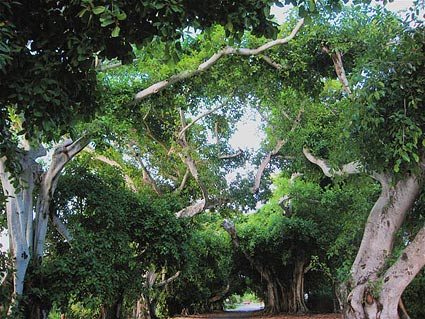
Banyan Street
Boca Grande, Florida
Banyan Tree Allée Boca Grande, Florida
history continued
Banyan trees, native to India, Sri Lanka, and Pakistan, have been used for ornamental purposes in tropical areas throughout the world. The large trees spread by forming accessory trunks, creating a dense canopy of shade. The fast growing trees require good soil and ample water and sun to encourage the thick growth of leaves. The trunks are nearly grotesque in their twisting form. Thick aerial roots appear to drip downward, providing support for the heavy branches. Their leaves are dark green in color, broad, and flat.
Located on Florida’s Gulf Coast, the island was subject to almost a dozen major storms during the 20th century. Low lying areas of the island, like Banyan Street, often flood during these storms. The first severe storms after the trees were planted occurred during the 1920s, when the trees were less than a decade old. A 1944 hurricane caused extensive damage, downing many of the island’s trees. Since then, Gasparilla Island has been hit by three major storms, the most recent, Hurricane Charley, which struck in August 2004. Although Hurricane Charley caused significant damage to the allée, only one of the banyan trees toppled during the storm. Despite measures to right the tree following the storm, it did not survive.
